Motorcycles have something in common with lawn mowers and weed whackers: It’s common for them to just sit for months during the off season. This makes them all vulnerable to the same problems, such as flat (and flat-spotted) tires, dead batteries (if you forgot to hook up the trickle charger) and the hard-to-starts . . . if you didn’t drain the gas or treat the gas before you put them up for the season.
But there is an important difference.
Not properly servicing a mower or weed whacker before you try to use it might flat-spot your lawn or wear out your pull-arm trying to get it started. Riding a bike with a flat-spotted tire or loose chain could flat-spot you.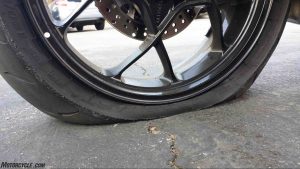
Hopefully, you “walked” the bike around the garage once a month or so during the off season, which is a way to take the weight off the one spot its weight would otherwise be pressing down on all winter, leading to a flat spot – a potentiality that becomes more so if you let the tires get low on air, too.
Check the tires for flat spots – and correct pressure – before you ride the bike. Also tread. Bike tires tend to wear more unevenly than car tires because bike tires roll when they turn. When they aren’t, the center section wears, usually faster than the sides. If the wear is uneven, the bike may handle weirdly in the turns as the tire rolls. This is a particular issue with soft-compound sport tires, some of which are only good for a season or maybe two – and less than 2,000 miles.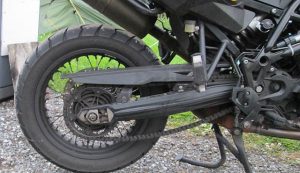
Other things worth checking include:
The chain, if you’re bike has one –
Even if you left it tensioned – and lubed – properly last fall, by now it may have accumulated a layer of dust, which is grit and that is not good. There may also be rust and in any case, the chain is a critical link that should never be taken for granted. Losing one at 100 MPH can truly spoil your day – possibly forever. It’s sound policy to remove it, check it, clean it and re-lube/re-tension it before you you ride. Don’t forget to check/clean (and replace, if necessary) the sprockets, either.
The shaft drive (or belt) if your bike has that –
If it’s a shaftie, check that the lube in the axle is at the proper level; don’t assume it is. There is often very little lube in bike axles and the loss of a few ounces through seepage can mean the loss of your shaft drive – which maybe won’t hurt you but will definitely hurt your wallet.
Check the condition of the boot, too.
The brakes, and not just them –
The pads are obvious. The lines are at least as critical, if they fail. Eyeball each one, from the master cylinder to the caliper. Any with cracks or evidence of seeps needs to be replaced. Pay particular attention to the front brakes as on most bikes, the brakes aren’t linked and the front brake does most of the stopping. If you lose that one, you might lose more.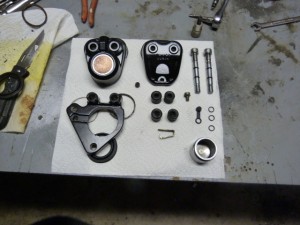
Since it is both easy and inexpensive to replace the brake fluid that should be done as well. A pint is generally enough to completely bleed the system and the small cost and hassle hugely outweighs the potential consequences of water or air in the lines, a failed master cylinder or similar caused by crap in the lines.
Do the clutch fluid (which uses the same brake fluid) as well.
The suspension, front and rear –
This includes the forks. Check the seals; any signs of leaks and the bike ought not to be ridden until there aren’t any. While holding the bike upright push the front end up and down and look for oil on the tubes. If there isn’t, you’re good. Check the dust boots for cracks and replace, if you find any.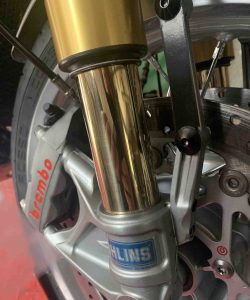
Do the same for the rear. If your bike has a shock(s) with a reservoir(s) look for leaks and do not ride if you find any. If the swingarm has a grease nipple, lube it. Check front and rear wheels for free movement; both should roll freely without much drag.
Oil/filter/coolant –
Bikes tend to not accrue miles as rapidly as cars so time is the more relevant consideration. A bike that’s sat for months could probably use fresh oil and a new filter, especially if it’s a carbureted bike, because it is probable that gas has leaked from the carbs into the engine and thus, into the oil.
Check the air filter – for squirrel/mouse nests. The fiber is not good for your bike’s engine.
If the bike is water-cooled, check the coolant and how long it’s been since you last changed it. If you can’t remember, do it now. And note it – in a small notebook you keep with the bike, so you will know for next time. It’s not a bad idea to look inside the radiator if the bike is more than a few years old – not to make sure it’s full of coolant but to make sure it’s not full of scale. If it is, remove it and clean it. Bike radiators are small and much easier to deal with then car radiators.
Check all hoses, too – as you would with a car. If they’re older than six or so years, it’s good insurance to just replace them (and note when you did).
Now the bike is ready to ride – mechanically.
But what about legally?
Because bikes sit for months, it’s easy to forget to keep the various stickers – and even insurance – up to date. Any of these can result in a stop, not for mechanical reasons but still-expensive reasons.
Don’t give them a reason to ruin your ride!
. . .
Got a question about cars, Libertarian politics – or anything else? Click on the “ask Eric” link and send ’em in!
If you like what you’ve found here please consider supporting EPautos.
We depend on you to keep the wheels turning!
Our donate button is here.
If you prefer not to use PayPal, our mailing address is:
EPautos
721 Hummingbird Lane SE
Copper Hill, VA 24079
PS: Get an EPautos magnet or sticker or coaster in return for a $20 or more one-time donation or a $10 or more monthly recurring donation. (Please be sure to tell us you want a magnet or sticker or coaster – and also, provide an address, so we know where to mail the thing!)
My eBook about car buying (new and used) is also available for your favorite price – free! Click here. If that fails, email me at EPeters952@yahoo.com and I will send you a copy directly!


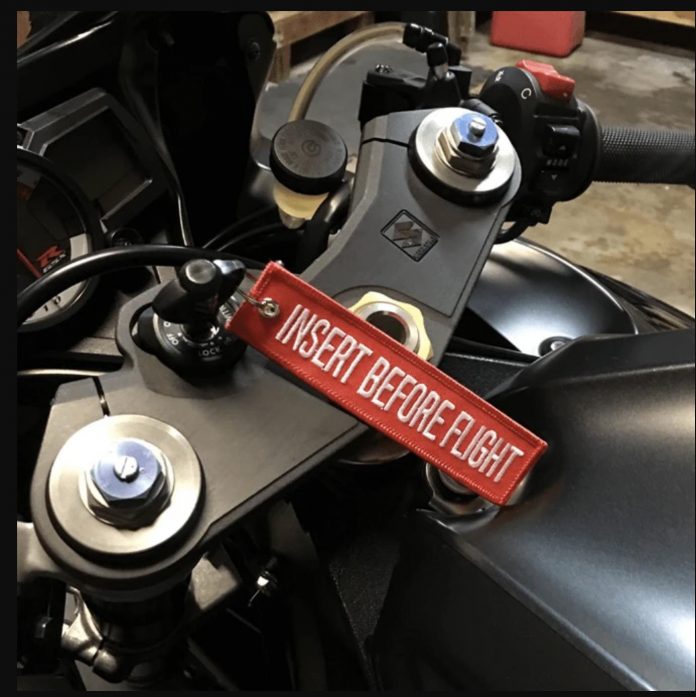








Good advice Eric. I overinflate my motorcycle tires sitting for the winter.
I run mousse bibs in my dirtbike and those have to come off and/or elevated off the ground, or they are wasted. Kids get a flat and ride it home. They have no idea the tire is gone. It is. I keep old decent ones around for them.
The weather has been spotty here in the NE, and have gotten a few rides in already.
I am like the tire nazi to all my friends. They laugh at me, but I don’t care. Before we ride I go around and check everyone’s tires. I won’t ride with them if there is a problem. Sometimes a new guy will come around I don’t know who just got his bike out and the tires are old and hard. Nope, no ride with you, but I will help you change your tires. I’ve even took a guys keys once, he was mad. I rode it back to his house.
Massive motorcycle show this past weekend in Texas, fandango! Took the cb500t up along with my dad on his triumph and my friend on his rz350. Not a mask in sight and 10s of thousands of people. Was a very nice time, almost “normal” one might say.
RE: Flat spotted tires.
When parking a car or bike for the winter I always inflate the tires to their max psi indicated on the sidewall. This keeps the whole tire symmetrical reducing the chance of flat spots and cracks. It also gives the tire more time from full to flat. Just remember to deflate to running pressure come spring or you’re in for a rocky ride.